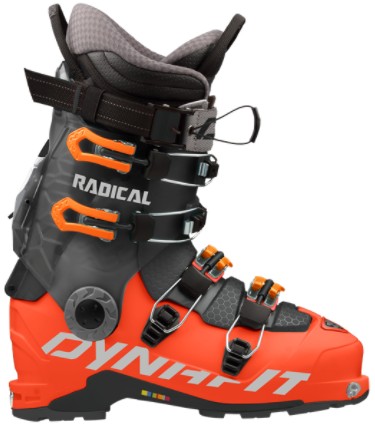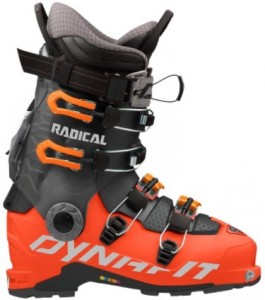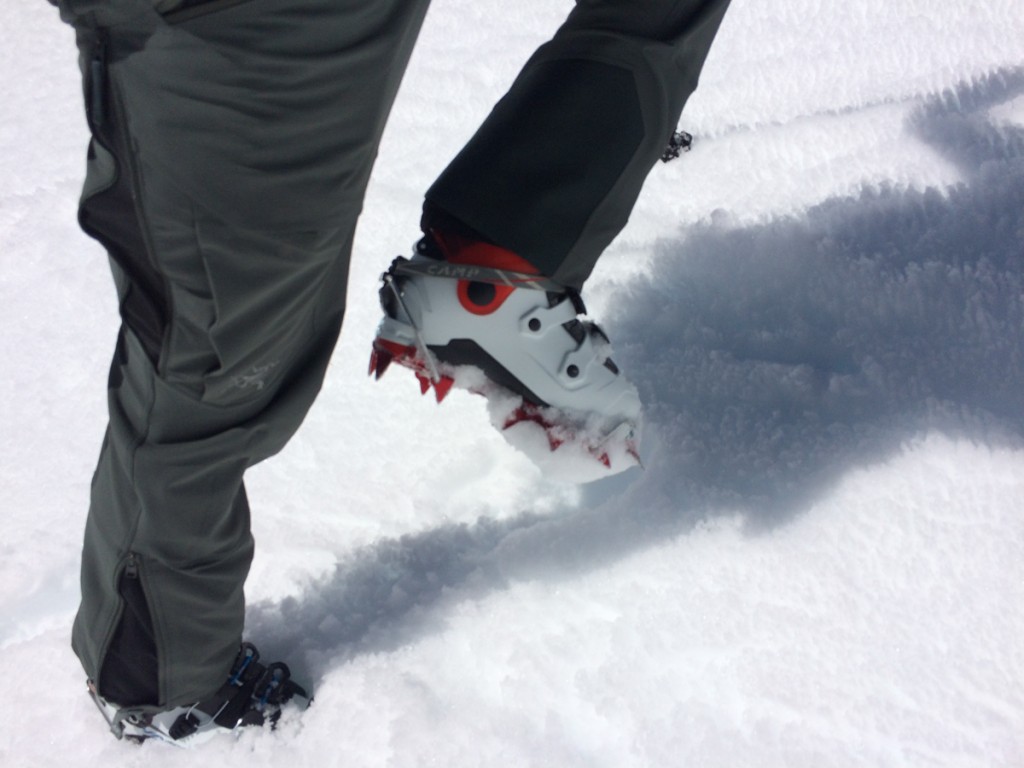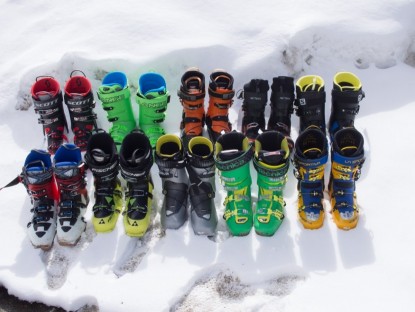Dynafit updated the look and name of the Radical. The previous name was the Radical CR. The "CR" stood for Custom Ready liners, which means they are thermomoldable to allow for a customized fit. The most recent Radical, displayed above, still features Custom Ready liners, but the "CR" is no longer part of the name. Other than the graphics and color updates, this boot offers identical performance to the model we tested for months on end.
Dynafit Radical Boot Review
Our Verdict
Dynafit updated the look and name of the Radical. The previous name was the Radical CR. The "CR" stood for Custom Ready liners, which means they are thermomoldable to allow for a customized fit. The most recent Radical, displayed above, still features Custom Ready liners, but the "CR" is no longer part of the name. Other than the graphics and color updates, this boot offers identical performance to the model we tested for months on end.
Our Analysis and Test Results
The 2018 Radical vs. The 2017 Version
As stated above, the only changes to this product involve its look and its name. Performance is the same in the boot we tested and this most recent version. In the photos below, the latest Radical Boot is on the left.
Hands-On Review
The Radical, from Dynafit, is an interesting step "sideways" for this perennial ski, binding, and boot innovator. Dynafit has long led the charge in the market, simultaneously improving bindings and boots, making both better for touring and better for skiing. In doing so, their products often look very different from those from other companies. In this way, their appeal is great among "early adopters", but lags behind with those that prefer familiarity.
Our Editors' Choice, the Dynafit TLT 7 Performance, is about as different looking as an all-around AT ski boot can be. The function is great, but it looks funny. The Radical looks just like all-around AT boots have looked for 20 years. It has a modified "three-piece", tongue style construction, four buckles, and a sole compatible with tech bindings, DIN AT bindings, and regular step-in crampons. What sort of function follows this form? Read on to find out more.
Uphill Performance
As compared to the entire spectrum of boots we tested, the Radical tours right in the middle. The "beef boots", like the Top Pick Lange XT FreeTour 130 and the Tecnica Zero G Guide are far more confining, while the Top Pick Scarpa Alien RS and the Editors' Choice Dynafit TLT 7 Performance both tour much better. Also, the Arc'teryx Procline Carbon Lite tours better than the Radical. The touring ability of the Radical is informed by the cuff articulation, which is in turn a function of some careful engineering and a bunch of plastic. These are bulky boots.
For that reason, there is a fair amount of material to rub and flex with each step. Given that, it is impressive how well they actually do tour. It seems that by minimizing the tongue bulk and by carefully crafting the cuff pivots and ski/walk mode lever, Dynafit has reduced the friction while keeping a fair amount of material in the boots. As compared to the closest competitors, like the similarly configured La Sportiva Spectre 2.0 and the Scott Cosmos III, the Radical tours better. There is a greater range of motion, and less friction, in the junction of upper and lower boot.
Weight
The Radical tours better than the Scott and La Sportiva, while costing more than $100 less than either one. Something had to give. In this case, it is the weight and downhill performance. The Radical weighs more than a pound more than these other two close competitors. It is remarkably close in mass to that of the excellent downhill skiing Lange XT FreeTour 130 and the Tecnica Zero G Guide. The only other boot that weighs more is the Fischer Transalp Vacuum TS. The Fischer packs on the pounds with a special plastic that is the most adjustable and moldable in our entire test. Basically, to get this touring ability and to earn our Best Buy award for cost, a weight penalty might have to be accepted.
Downhill Performance
As mentioned already, the Radical has made no great impression in terms of downhill ability. In assessing downhill chops, we look basically at boot stiffness. Skiers want a boot that supports firmly to the sides and to the rear, with a forward flex that is strong, with a steady increase in support as the skier presses his or her shins forward. Like all "tongue style" boots, the forward flex of the Radical isn't perfectly "progressive". To attain a reasonable amount of flex, the Radical skier will inevitably come up against a "hard stop" as he or she presses forward. In terms of lateral and rearward flex, the inexpensive plastic construction leaves the Radical a bit lacking. On a big and rowdy day of ski mountaineering for the San Juan Mountain's infamous "Elevator Shaft" couloir, our lead test editor found the support to be adequate for steep, controlled jump turns on small skis, but was unable to justify big, high-speed turns for fear of losing an edge.
The boots just feel soft and unsupportive to the sides. In terms of rearward support, in most conditions, a centered skier with good technique shouldn't need much. However, when things get weird, in terms of conditions or technique, having some confidence inspiring rearward support is good. The Radical doesn't inspire that confidence. Basically, this boot skis like one of the specialized boots, like the Arc'teryx Procline Carbon Lite or the Top Pick Scarpa Alien RS. The Editors' Choice TLT 7 is 60% the mass of the Radical but skis better.
Comfort and Fit
We loved the fit of the Radical right out of the box. The width and volume is on the narrow side of medium. Anyone but those with the widest of feet should be able to acquire a good fit with little more than liner molding. The liner is thick and forgiving. The toe box is roomy for long days on the go. The last, predictably enough, feels very similar to that of the TLT 7. It is also somewhat similar to the fit of the Tecnica. The Salomon S/Lab MTN is quite a bit narrower, while the Atomic Backland Carbon is definitely wider.
Warmth
With thick shell plastic and a "proper" liner, the Radical is as warm as an AT ski boot can get. It is in the same category as the Lange XT, the Fischer Transalp, Atomic Hawx, and the Salomon S/Lab MTN. The lighter boots are colder, with the super specialized Arc'teryx Procline and the Atomic Backland being little more insulating than light mountaineering boots.
Ease of Use
Of the four-buckle, "traditional" style AT ski boots we tested, the Radical is the easiest to use. The walk/ski mode is reliable and simple. The buckles work smoothly. The top "power strap" is clean, slick, and lacks the velcro that others use. Velcro "power straps" are great, and traditional. However, they are finicky at transitions, and when in touring mode the exposed "hooked" fabric can abrade the inside of your pants cuffs.
The cam-lock buckle of the Radical's power strap (exactly the same as that on the TLT 7 Performance, and fairly similar to that on the Arc'teryx Procline and the Salomon S/Lab MTN) is easier to tighten, easier to loosen, easier to thread, and doesn't leave exposed velcro to snag on pants. Win, win, win, win; We dig it.
Best Applications
These are excellent entry-level AT ski boots for technically proficient skiers that will avoid serious downhill terrain and conditions. The price is affordable, the touring mode is great, and the construction is durable. Skiers at either end of the spectrum (both beginner and those demanding a lot from the downhill performance of their gear) will be disappointed by the downhill performance of the Radical and should consider one of the other products in our test.
Value
The Dynafit is the least expensive shoe in our test, and tours better than much of the field. It certainly tours better than anything within hundreds of dollars in cost. If you can tolerate the compromises in weight and downhill performance, it is an excellent value.
Conclusion
Choose carefully, as this isn't the best boot for everyone. However, for the occasional user with tame ski aspirations, it is an easy way to get one's foot in the door with backcountry skiing.










